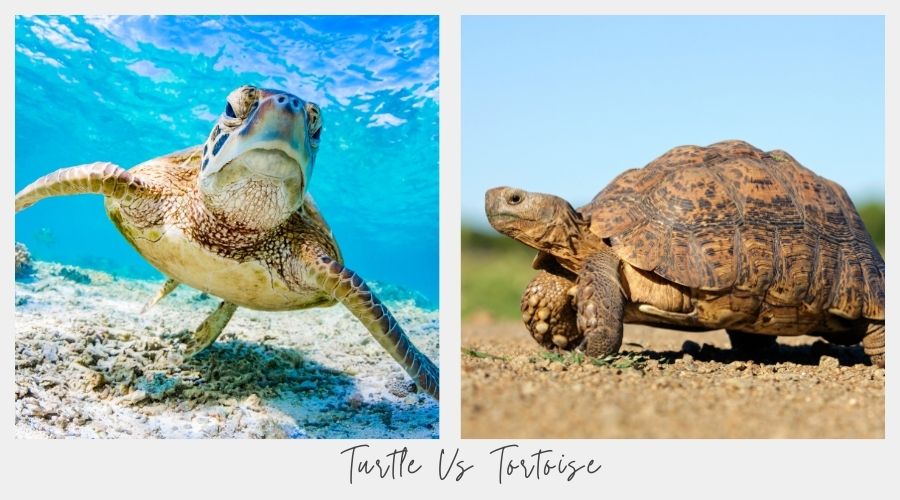Are turtles and tortoises the same? Can you call a tortoise a turtle, what is the difference between turtles and tortoises? If you have thought about these questions before, you are not alone.
Allow us to break it down for you.
Are Turtles And Tortoises The Same?
Turtles and Tortoises are both reptiles of the order, Testudines. Their main characteristic is the shell covering which develops from their rib cage and is part of their spine. The shell is their main protection from any danger.
Just like all other reptiles, both turtles and tortoises have scales and lay their eggs on land which they bury in soil, sand, or vegetables.
They are both ectothermic, or cold-blooded which means they regulate body temperature through external means, like being in the sun, shade, or otherwise. Both the turtle and tortoise have no teeth, instead, they make use of the hard edges of their mouths to bite.
In these aspects, turtles and the tortoises are the same.
Can you call a tortoise a turtles? Well here lies the crux, stick with me as I explain below.
Are All Tortoises Turtles?
The word turtle can refer to two things: Turtle is the blanket term for all the Testudines explained above, all 360 species, that is inclusive of all tortoises and terrapins. At the same time, the word turtle is used to specifically refer to the Testudines that live in water, aquatic or semi-aquatic.
Therefore, all tortoises are turtles but not all turtles are tortoises.
Tortoises are commonly found in hot and dry habitats, They inhabit the southern part of both Americas, the Mediterranean, Eurasia, and Sub-Saharan Africa. However, they are not found in Australasia.
Exclusively land-dwelling, the tortoises have some differences with the turtles.
Related: How long do turtles live?
What’s the Difference between a Turtle and a Tortoise?
Turtles and tortoises differ in the following aspects:
Habitat
In the family of shelled reptiles, the tortoise is the only one that exclusively resides on land.
Most species occupy semiarid habitats. For example, the Agassiz’s desert tortoise found in California, the Morafka’s desert tortoise found in Nevada, Utah, and Arizona, the Texas Tortoise in Texas, and the Bolson tortoise found in Mexico.
Turtles on the other hand are aquatic or semi-aquatic and live nearly all of their lives in water. They are widely distributed across the world’s oceans, and islands with aquatic, and semi-aquatic species.
Sea turtles are mainly tropical and subtropical. There are 7 different species of sea (or marine) turtles gracing our ocean waters. These species migrate a lot and move from the shallow seagrass beds to the deep colorful seas. They mostly come ashore to bask or nest, they spend most of their time in the waters.
Physical Differences and Swimming Ability
The tortoise has been famed for having small round elephant feet and is generally slower than the turtle, even on land. The tortoise has a clocking speed of 0.13 to 0.30 mph.
The turtles’ limbs are adapted for various movements on land and in water. The turtle’s feet are webbed and have long claws to provide a good grip for holding floating logs on riverbanks. Some turtles have flippers, the pig-nosed turtle being one of them. Marine turtles have a clock swimming speeds of 19 mph.
Here is a summary of the key differences between turtles and tortoises
| Turtle | Tortoise | |
|---|---|---|
| Habitat | Dwells mostly in water | Exclusively dwells on land |
| Distribution | Africa, America | Africa and Asia mostly, some species are found in America too |
| The shape of the shell | Mostly flat, streamlined shells | Large dome-shaped shells |
| Weight of the shell | Generally light-weight shells | The shells are heavier |
| Limbs | Webbed feet with long claws | Feet are short and cylindrical shaped with bent legs |
| Diet | Turtles are omnivores | Most tortoise are herbivores |
| Birth | Turtle hatchlings stay in their nest on their own for 1 to 3 years | Tortoise hatchlings move from their nest to the mothers’ burrow soon after birth |
| Lifespan | 20-40 years. The oldest was 86 years | 80-150 years. The longest living Tortoise is 326 years |
Are They Endangered?
Over the last 200 years, human activities have led to a decrease in the population of both turtles and tortoises, especially the sea turtle. [1]
Slaughtered for their eggs, meat, skin, and shells as well as being affected by climate change. The Sea turtles are now classified as endangered species.
Related: Do turtles shed their shells?
Conclusion
Are turtles and tortoises the same you asked?
The answer: All tortoises are turtles but not all turtles are tortoises.
I bet you have never met someone afraid of tortoises, have you now? Most likely not and that is because of how adorable, cute and inoffensive they are. Even the term Herpetophobia (fear of reptiles) is mostly used for the other reptiles and not the tortoise.
Imagine you told a neighbor that you keep reptiles and they come over and see the cute tortoise slowly munching on the grass in the backyard. They will probably invite their kids to come to play and take pictures.
Let’s protect our friendly neighborhood reptile so that the coming generations may witness their slow and steady grace.


